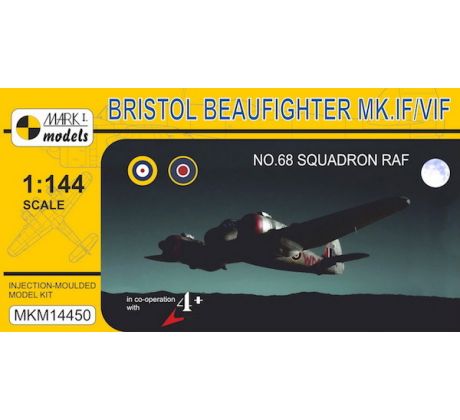Bristol Beaufighter Mk.IF/VIF 'No.68 Sq. RAF'

Bristol Beaufighter Mk.IF/VIF 'No.68 Sq. RAF'
This injection-moulded kit contains 51 parts, 3 resin parts and five clear parts (cockpit canopies, position lights etc.). A comprehensive instruction leaflet and a decal sheet are included.
Colour schemes included in the kit:
1) Bristol Beaufighter Mk.IF, X7583, Grey WM-E, No.68 Sq., RAF, High Ercall airfield, autumn 1941
2) Bristol Beaufighter Mk.IF, X7842, Red WM-P, 'B' Flight, No.68 Sq., RAF, Coltishall airfield, summer 1942
3) Bristol Beaufighter Mk.VIF, MM850, Red WM-L, No.68 Sq., RAF, Coltishall airfield, October 1943
4) Bristol Beaufighter Mk.VIF, V8656/G, Red WM-U, No.68 Sq., RAF, Coltishall airfield, spring 1943
| Ref. No.: | MKM144050 |
| Availability: | IN STOCK |
Bristol Beaufighter Mk.IF/VIF 'No.68 Sq. RAF'
The Bristol Beaufighter was a British heavy fighter, whose first prototype flew in July 1939. The Mk.IF was a high performance fighter and efficient night-fighter employing the then novel AI radar. It was a two-seat, twin engine, all-metal mid-wing cantilever monoplane, fitted with a retractable undercarriage. It was powered by two Hercules radial engines and the armament consisted of four cannons in the nose, four guns in the starboard wing and another two guns in the port wing. The Beaufighter Mk.VIF, introduced in 1942, was fitted with more powerful engines and its wing mounted guns could be replaced by additional fuel tanks to extend the aircraft's range.
Total production of the Mk.I (both F and C variants) reached 914 aircraft while some 1,840 Mk.VI aircraft were produced. Late series Mk.VIs were fitted with a dihedral tailplane with increased span. From late 1943, a new AI Mk.VIII radar was installed in a "thimble-nose" radome, enabling all-weather and night attacks.
Beaufighters were taken on charge by No.68 Sq. RAF in May 1941 and from the next July, the unit always had a strong element of Czechoslovak pilots in exile with up to eight flying crews consisting entirely of Czechoslovak personnel.
The Czech crews of No.68 Squadron were credited with 24 aerial victories (of which 3 were probable), seven damaged planes and three destroyed V-1 flying bombs.
Products purchased together with this product
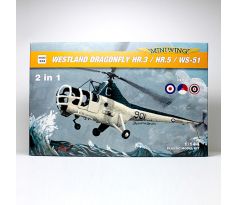
Westland HR.3 / HR.5 DRAGONFLY
British helicopter
Description:
26 Plastic parts from clear material
Canopy mask
Decals for 4 helicopters
2 kits in 1 boxt
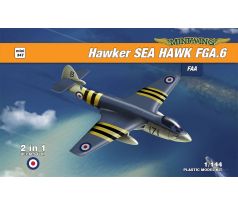
Hawker SEA HAWK FGA.6 FAA
British Carrier Based Fighter / Attacker
Description:
30 plastic parts
2 kits in the box
decals for 3 versions of FAA
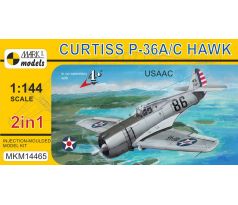
Curtiss P-36 Hawk 'USAAC' (2in1)
Two injection-moulded kits are supplied in this box and each kit contains 30 parts and four clear parts (the cockpit canopy, rear windows and a landing light). A comprehensive decal sheet is included.
Colour schemes included in the kit:
1) Curtiss P-36A Hawk, 48 15P, Black 86, 46th Pursuit Squadron, 15th Pursuit Group, USAAC, Wheeler Field, Oahu, Hawaii, December 1941
2) Curtiss P-36A Hawk, PT 96, 55th Pursuit Squadron, 20th Pursuit Group, USAAC, Barksdale Field, Louisiana, 1940
3) Curtiss P-36A Hawk, 2 15P, 47th Pursuit Squadron, 15th Pursuit Group, USAAC, Haleiwa Fighter Strip, Oahu, Hawaii, December 1941
4) Curtiss P-36C Hawk, Black 69 (Class II experimental camouflage scheme), 27th Pursuit Squadron, 1st Pursuit Group, USAAC, Selfridge Field, Michigan, during National Air Races, Cleveland Airport, Ohio, September 1939
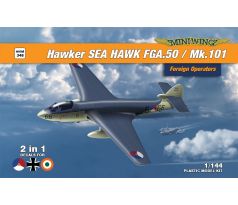
Hawker SEA HAWK FGA.50 / Mk.101 Foreign Operators
British Carrier Based Fighter / Attacker
Description:
30 plastic parts
2 kits in the box
decals for 3 versions of Netherland, West Germany and India
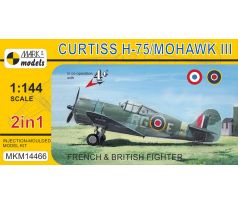
Curtiss H-75/Mohawk Mk.III 'French & British Fighter' (2in1)
Two injection-moulded kits are supplied in this box and each kit contains 29 parts and four clear parts (the cockpit canopy, rear windows and a landing light). A comprehensive decal sheet is included.
Colour schemes included in the kit:
1) Curtiss-Hawk H-75A-1, No.16, White 9, 1st Escadrille, GC I/5, French Air Force (Armée de l'Air), Reims airfield, France, summer 1939
2) Curtiss-Hawk H-75A-1, No.26 (X825), Yellow 2, 2nd Escadrille, GC I/5, French Air Force (Armée de l'Air), Reims airfield, France, autumn 1939
3) Curtiss-Hawk H-75A-2, No.140 (U040), Black 1, 3rd Escadrille, 2nd Groupe, CIC Fighter Training School, French Air Force (Armée de l'Air), Chartres airfield, France, autumn 1939
Curtiss-Hawk H-75A-2, No.140 (U040), White 11, 3rd Escadrille, GC II/5, French Air Force (Armée de l'Air), CIC Fighter Training School, Chartres, April/May 1940 and Toul-Croix-de-Metz airfield, France, early June 1940
4) Curtiss Mohawk Mk.III, AR633 (ex-Norwegian H-75A-6 No.481), Grey RG-E, No.510 Sq., RAF, Hendon airfield, U.K., late 1943


